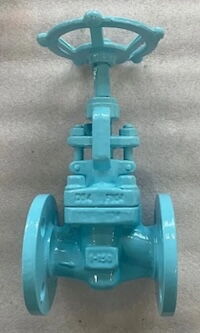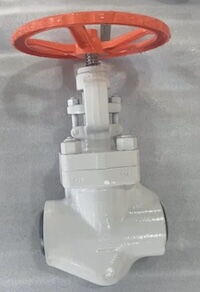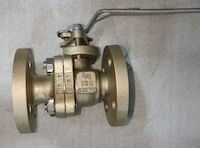Mitigating Hydrogen Corrosion in High-Pressure Hydrogenation Gate Valves
Jan 02, 2025
Hydrogen corrosion is a critical issue for the metal components of high-pressure hydrogenation gate valves operating in hydrogen-rich environments. Therefore, selecting appropriate materials and surface treatments is essential. Materials with superior hydrogen corrosion resistance must be selected for these valves. Commonly used corrosion-resistant materials include austenitic stainless steel, nickel-based alloys, and titanium alloys. The phosphorus (P) and sulfur (S) content must be carefully controlled during casting or forging to enhance material strength, ductility, and resistance to hydrogen corrosion.
Surface treatments are highly effective in enhancing the hydrogen resistance of these materials. Common methods include nitriding, carburizing, nickel plating, and plasma spraying. These treatments form a protective layer on the metal surface, preventing direct contact between hydrogen atoms and the material, thereby improving resistance to hydrogen embrittlement. Advanced surface treatments, such as Diamond-Like Carbon (DLC) coatings and ceramic coatings, further enhance hydrogen corrosion resistance, reducing the risk of material degradation. Machinability should also be considered during material selection and surface treatment to ensure components are free from internal defects and maximize valve service life in hydrogen-rich environments. In the design phase of high-pressure hydrogenation gate valves, materials must be selected according to relevant standards. Appropriate surface treatments should then be applied to enhance corrosion resistance under high-temperature, high-pressure conditions.
When designing high-pressure hydrogenation gate valves, it is essential to adhere strictly to industry standards, such as JB/T 11484-2013 "Technical Specifications for Valves for High-Pressure Hydrogenation Devices," and to consider stress concentrations that can occur during manufacturing. Stress concentration areas in metal parts are particularly susceptible to stress corrosion cracking and fatigue, which can be intensified by hydrogen corrosion. To address these issues, the design should incorporate fillet transitions and avoid sharp corners, thereby improving both fatigue resistance and hydrogen corrosion resistance. The machining process is essential for mitigating hydrogen corrosion. Advanced machining technologies should be employed to improve surface finish, as surface defects such as cracks and pores can act as initiation sites for stress corrosion and fatigue failures. Improving the surface finish of valve components can significantly reduce the risk of hydrogen corrosion. Additionally, a controlled heat treatment process should also be used to address residual stresses within the material. Residual stress can accelerate stress corrosion and lead to the formation of fatigue cracks, thereby increasing the likelihood of hydrogen corrosion. Hydrogen corrosion in high-pressure hydrogenation gate valves may lead to failure and safety incidents. To extend the service life of these valves, addressing hydrogen corrosion is crucial. This paper provides a guide for mitigating hydrogen corrosion, based on an analysis of its causes and supporting experimental research.
During extended operation, high-temperature, high-pressure hydrogen and crude oil flow through the high-pressure hydrogenation gate valve at high velocity. Under these high-velocity, high-pressure conditions, the plate and valve seat surfaces undergo significant scouring, leading to metal erosion. Scouring erosion is caused by the relative motion between hydrogen and components such as the plate and valve seat. Eddy currents in the valve’s grooves significantly influence particle movement and erosion. Prolonged scouring results in wear, corrosion, and fatigue cracking on the component surfaces, which reduce sealing performance and shorten the valve’s service life.
Scouring erosion due to the hydrogen medium significantly affects the performance of high-pressure hydrogenation gate valves. First, erosion reduces the valve’s sealing performance, leading to hydrogen leakage and undermining the stability and efficiency of the refining process. Second, erosion shortens the valve’s service life, increasing maintenance costs and raising operating costs for the refinery. Finally, severe erosion can lead to leakage and safety hazards, posing a serious threat to refinery operations.
- After prolonged use, the plate and valve seat surfaces show wear marks due to the high-velocity flow of hydrogen. The contact surfaces of the plate and valve seat are severely eroded, leading to progressive erosion that affects the valve’s sealing performance.
- Pits and cracks form on the inner walls of the valve, further eroding the plate and valve seat surfaces, reducing the valve’s sealing performance and increasing the risk of leakage.
- Scouring erosion may prevent the valve from closing properly, resulting in leakage. This disrupts the stability and efficiency of the refining process and contributes to environmental pollution.
- Severe scouring and wear may prevent the valve from operating correctly, leading to incidents that jeopardize safety.
To address scouring erosion issues, high-pressure hydrogenation gate valves can be optimized through the following measures:
- During the design and material selection phases, prioritize corrosion- and wear-resistant materials, such as nickel-based alloys, to enhance the wear and scouring resistance of the plate and valve seat.
- Scouring and wear can be minimized by optimizing the structural design of the plate and valve seat, such as using specially shaped components to reduce hydrogen’s scouring effect and extend service life.
- For metal components like the plate and valve seat, applying a wear-resistant coating can significantly enhance their wear and corrosion resistance.
During operation, valve scouring erosion caused by the hydrogen medium are complex processes, particularly during valve opening and closing. Among these, the flow rate of the hydrogen medium is the primary factor influencing scouring erosion. The high-velocity hydrogen medium strikes and wears the walls of the valve’s flow channel, which is continuously exposed to a hydrogen-corrosive environment. Impurities in the hydrogen medium, particularly particulate matter, contribute to abrasive wear on the valve’s flow channel walls. To mitigate abrasive wear, the hydrogen medium should be purified to reduce its impurity content.
Additionally, the hardness and surface roughness of the valve's metal components significantly affect their resistance to scouring erosion. If the metal’s hardness is insufficient or its surface roughness too high, the component surface becomes more prone to hydrogen-induced erosion and material degradation. Therefore, selecting high-hardness metals, applying advanced surface treatments, and controlling component surface finish can significantly improve wear resistance and extend service life. Refining the valve’s flow path during design to reduce turbulence and dead zones also minimizes scouring erosion caused by the hydrogen medium.
Advancements in materials and processing technologies have improved the design and manufacturing capabilities of high-pressure hydrogenation gate valves, resulting in enhanced performance and longer service life with respect to scouring erosion resistance.
High-pressure hydrogenation gate valves in the oil refining industry operate under extreme conditions, including high temperatures, high pressures, and hydrogen corrosion. These conditions impose stringent performance requirements. First, high-pressure hydrogenation gate valves must be made from materials with excellent hydrogen corrosion resistance, and the metal components must meet specific strength criteria. Selecting appropriate processing technologies and optimizing the valve design to enhance wear resistance are also crucial. Second, during operation, the valve’s metal components are exposed to hydrogen corrosion and erosion caused by the hydrogen-rich environment. This can cause brittle fractures or damage to the sealing surfaces, potentially leading to leakage and safety hazards. Finally, the gate valve must provide reliable sealing to prevent leaks. It should also possess high strength and toughness to withstand demanding operating conditions, such as stress fluctuations from high pressures and temperatures. This article offers insights into the design and manufacture of high-pressure hydrogenation gate valves in the oil refining industry, focusing on their failures.
Previous: Hydrogen Corrosion in High-Pressure Hydrogenation Gate Valves
Next: State Monitoring and Fault Diagnosis of Electric Valves


